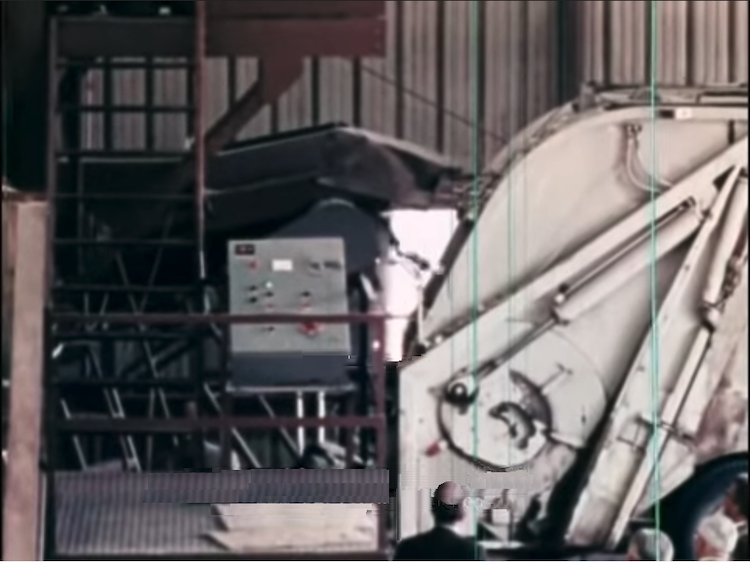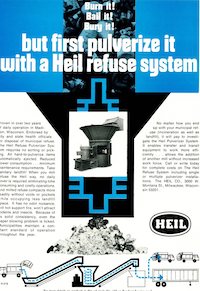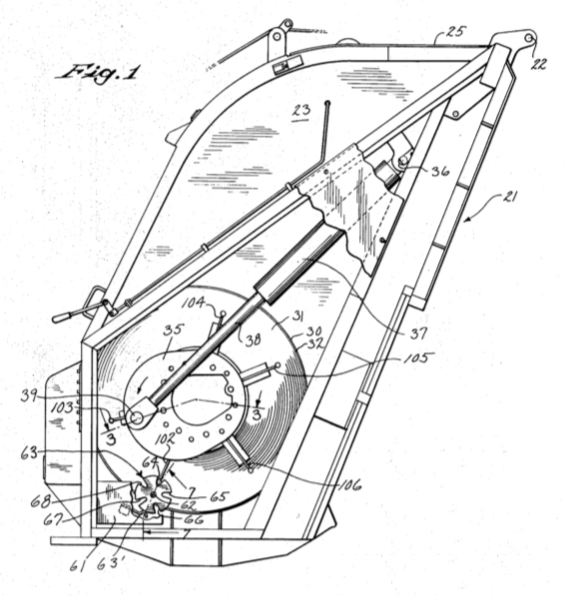 
Heil Continuous-Loading Revolving-Blade Rear Loader

Maybe the rarest Heil of all; the revolving-blade rear loader
The Heil revolving-blade rear loader is a design that, until recently, had been presumed to exist on paper only, or as a limited-production experimental model. While the latter may yet be true, the evidence shown on this pages proves that at least one was actually built for the City of Madison, Wisconsin, and used in their refuse-shredding plant in the late 1960s. The packer received a milled refuse stream from a conveyor belt, which it continuously swallowed, ultimately transporting and unloading the refuse at the landfill site.
Those familiar with the second-generation Shelvoke & Drewry Revopak will recognize the function of the outboard cylinders (depicted in the brief film clip) which operate the continuously-revolving disc, which in turn drives the blade. What differs from the well-known SD and SEMAT methods can't be seen, but is explained in the 1968 patent; the upper guide links (inside the tailgate) were actually powered by a second pair of hydraulic cylinders, imparting the oscillating action needed to control the blade on this type of packer. These two sets of cylinders, inboard and outboard, were alternately powered or released ("float" mode) by solenoid switchgear triggered by the revolving disc, so the disc would not stall "over center" in its arc. Additionally, during the packing stroke, both sets of cylinders were energized to provide maximum power. During this phase, the blade is being driven by four hydraulic cylinders at the same time! The blade edge was described as serrated, to crush and shear refuse at the hopper edge.
The Madison refuse shredding plant was built around 1967 by the Heil Company, and was one of the earliest examples of their Heil Pulverizer System. Heil's rear loader at the time was the Mark III Colectomatic, which was unsuitable for use in this application. This makes it highly likely that the Heil revolving-blade rear loaders were built especially for this facility, or similar installations. At that time, the only other continuous-cycling rear loader on the market in America was City Tank Corporation's Roto-Pac. However, the revolving-blade model may have also been considered for the role of the "Mark IV" in the Heil lineup of the late 1960s. There is no mention in the patent that this was anything but a rear loader for regular street refuse collection. Both the film and the patent seem to depict a container lift cable riding atop the tailgate. It is likely no coincidence that one of the designers was John Wieschel, who would lead the Mark V design team at Heil (see next chapter). The Mark V promotional material often mentions its "Full Circle Compaction", which did not involve a revolving blade, but used linkage to achieve a similar result.
As of this writing, no known literature, advertising or press releases regarding this model have yet surfaced. No model name is known, but following Heil practice of the time, it likely would have been called "Colectomatic Mark IV", or some variation of the "Colecto" theme. For the time being, it will remain one of the great lost classics of refuse truck design.

1969 Pulverizer ad (CLICK IMAGE TO ENLARGE)

1968 patent drawing, showing one of the outboard packing cylinders and revolving disc
Video clip of the packer working from the film "The Trouble With Trash":
Click here to watch the video on YouTube.com
PATENTS:
|
Patent # |
Description |
Inventor |
Assignee |
Date |
|
US3559825 |
Refuse Body Loading Mechanism |
Meyer, et al |
Heil Co. |
December 12, 1968 |
REFERENCES
Solid Wastes Management, January 1974, page 18B:
Seven-Year Experiment Evaluates Milling of Domestic Rubbish Under Various Climatic Conditions
|



3/20/21 (revised 3/28/21)
© 2021
All Rights Reserved
Photos from factory brochures/advertisements except as noted
Logos shown are the trademarks of respective manufacturers
|
| |